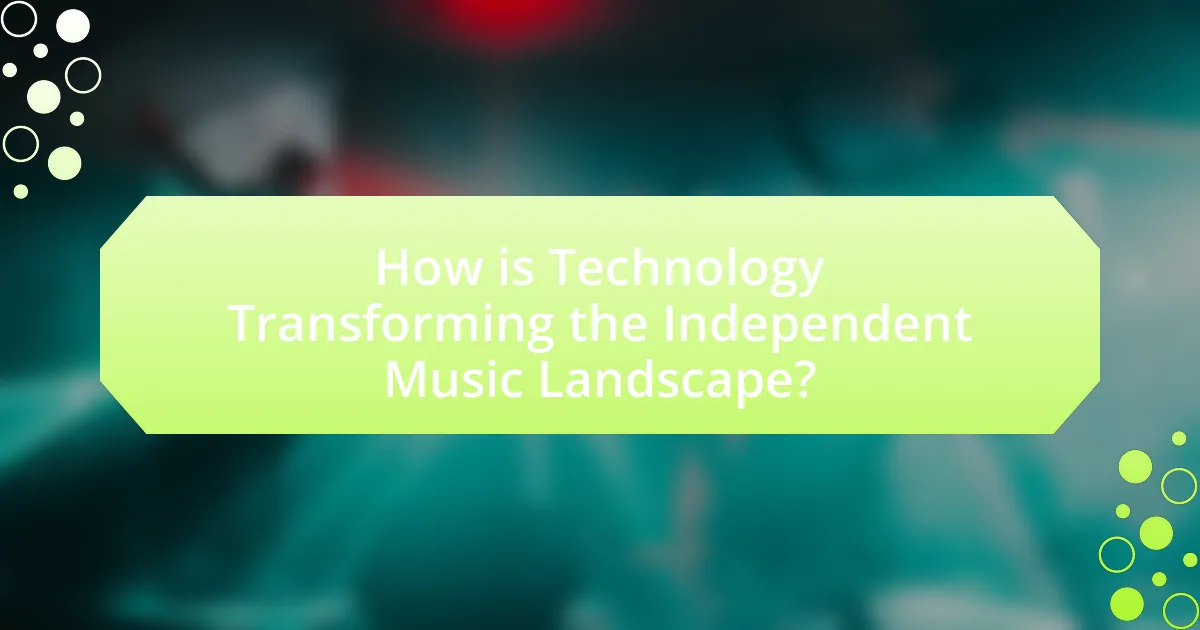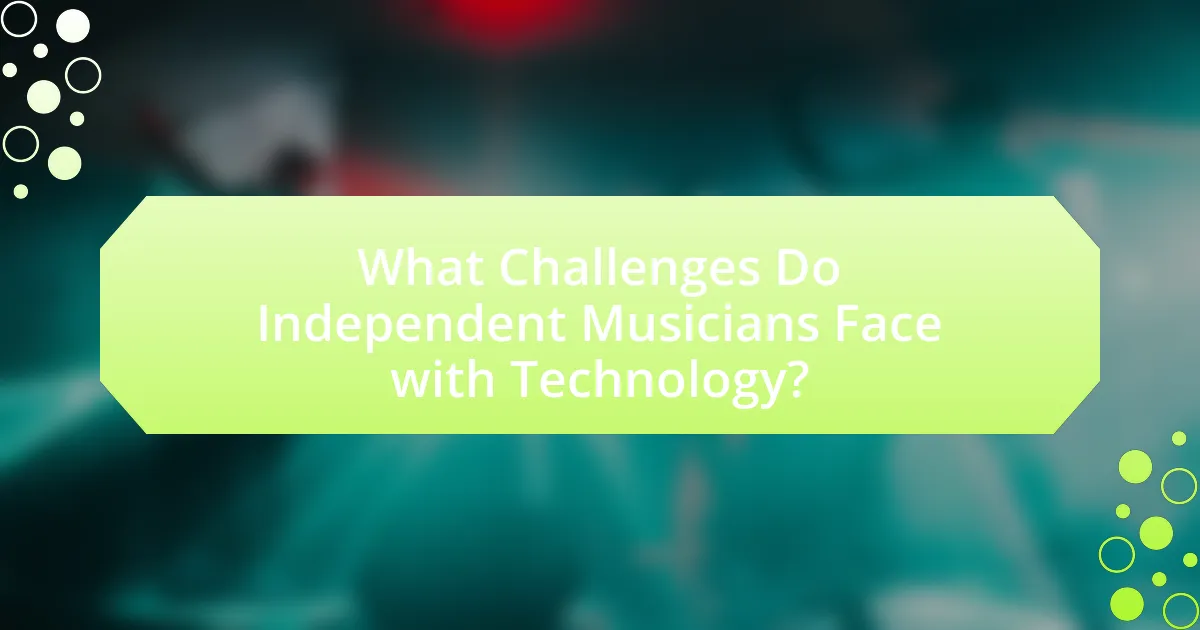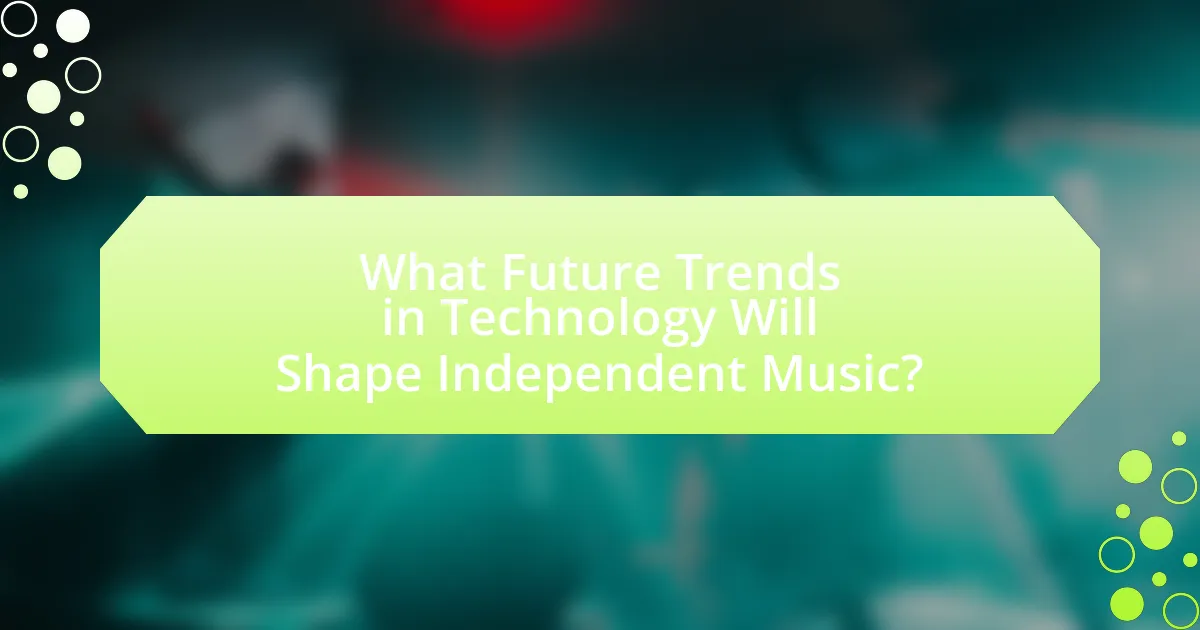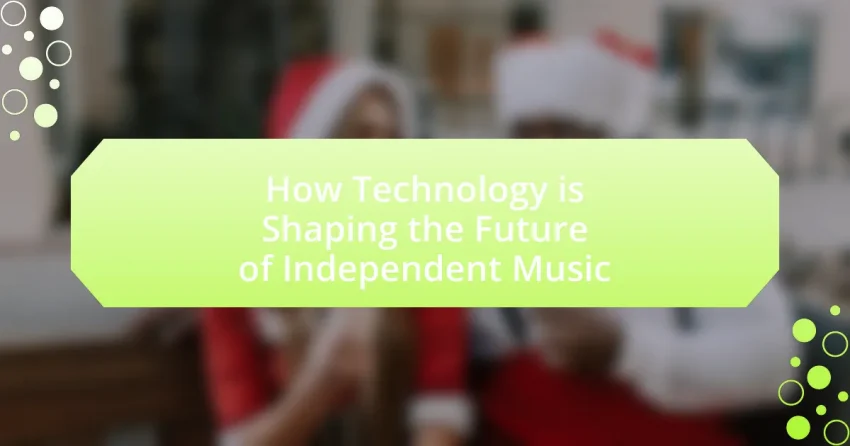The article examines how technology is reshaping the independent music landscape, highlighting the significant role of digital distribution platforms, social media, and music production software. It discusses the empowerment of independent artists through direct access to global audiences, enhanced creative freedom, and increased revenue opportunities. Key challenges such as technological barriers, oversaturation of content, and the risks associated with reliance on technology are also addressed. Additionally, future trends like artificial intelligence, blockchain, and immersive audio experiences are explored, emphasizing their potential impact on music creation, distribution, and artist promotion.

How is Technology Transforming the Independent Music Landscape?
Technology is transforming the independent music landscape by providing artists with unprecedented access to distribution, promotion, and production tools. Digital platforms like Spotify, Bandcamp, and SoundCloud enable independent musicians to reach global audiences without the need for traditional record labels. According to a 2021 report by the International Federation of the Phonographic Industry, independent labels accounted for 40% of global recorded music revenue, highlighting the significant impact of technology on their market presence. Additionally, advancements in music production software and affordable recording equipment allow artists to create high-quality music from home, further democratizing the music creation process. This shift empowers independent musicians to maintain creative control and build direct relationships with their fans, fundamentally altering the dynamics of the music industry.
What are the key technological advancements impacting independent music?
Key technological advancements impacting independent music include digital distribution platforms, social media marketing, and music production software. Digital distribution platforms like Spotify and Bandcamp enable independent artists to reach global audiences without traditional label support, significantly increasing their visibility and revenue potential. Social media marketing allows artists to engage directly with fans, promoting their music and building a community, which is crucial for independent success. Additionally, advancements in music production software, such as Ableton Live and Logic Pro, empower artists to create high-quality recordings from home studios, reducing the need for expensive studio time. These technologies collectively enhance the ability of independent musicians to produce, distribute, and promote their work effectively.
How do digital distribution platforms change the way artists share their music?
Digital distribution platforms fundamentally transform how artists share their music by providing direct access to global audiences without the need for traditional record labels. These platforms, such as Spotify, Apple Music, and Bandcamp, enable artists to upload their music directly, bypassing intermediaries and allowing for immediate release and distribution. According to a report by the International Federation of the Phonographic Industry (IFPI), over 70% of music consumption now occurs through streaming services, illustrating the shift in how music is accessed and consumed. This democratization of music distribution empowers independent artists to reach listeners worldwide, manage their own marketing, and retain a larger share of their revenue compared to traditional models.
What role do social media and streaming services play in artist promotion?
Social media and streaming services are crucial for artist promotion as they provide platforms for direct engagement with audiences and facilitate music distribution. Artists leverage social media to build their brand, connect with fans, and share content, which can lead to increased visibility and fan loyalty. For instance, a study by the International Federation of the Phonographic Industry (IFPI) found that 87% of music consumers discover new music through platforms like Instagram and TikTok. Streaming services, such as Spotify and Apple Music, enable artists to reach global audiences, with Spotify reporting over 400 million active users, allowing independent artists to gain exposure without traditional label support. These platforms collectively enhance an artist’s ability to promote their work effectively and efficiently.
Why is technology essential for independent artists today?
Technology is essential for independent artists today because it provides them with tools for creation, distribution, and promotion that were previously unavailable or inaccessible. Digital audio workstations enable artists to produce high-quality music from home, while platforms like Spotify and Bandcamp allow for direct distribution to global audiences without the need for traditional record labels. Furthermore, social media channels facilitate engagement with fans, enhancing visibility and building a loyal following. According to a 2021 report by the International Federation of the Phonographic Industry, independent artists accounted for 40% of global music consumption, highlighting the significant impact of technology in enabling their success.
How does technology enable greater creative freedom for musicians?
Technology enables greater creative freedom for musicians by providing access to advanced tools and platforms that facilitate music production, distribution, and collaboration. Digital audio workstations (DAWs) allow artists to create high-quality recordings from home, eliminating the need for expensive studio time. Additionally, online platforms like SoundCloud and Bandcamp enable musicians to share their work globally without traditional gatekeepers, fostering a direct connection with audiences. The rise of social media also allows for real-time feedback and engagement, empowering artists to experiment with their sound and marketing strategies. According to a 2021 report by the International Federation of the Phonographic Industry, independent artists have seen a significant increase in revenue due to these technological advancements, highlighting the transformative impact of technology on creative expression in music.
What are the financial implications of technology for independent artists?
Technology significantly reduces costs and increases revenue opportunities for independent artists. Digital platforms enable artists to distribute their music globally without the need for traditional record labels, which often take a substantial percentage of earnings. For instance, services like Bandcamp and Spotify allow artists to sell directly to fans, retaining a larger share of profits. Additionally, the rise of social media marketing provides cost-effective ways for artists to promote their work, reaching wider audiences without significant financial investment. According to a 2021 report by the Music Industry Research Association, independent artists who leverage technology can increase their income by up to 30% compared to those who rely solely on traditional methods.
How does technology influence music production and collaboration?
Technology significantly influences music production and collaboration by providing advanced tools and platforms that enhance creativity and accessibility. Digital audio workstations (DAWs) allow artists to record, edit, and produce music from anywhere, facilitating remote collaboration among musicians across the globe. For instance, platforms like Soundtrap and Splice enable real-time collaboration, allowing multiple artists to work on a project simultaneously, regardless of their physical location. Additionally, the rise of cloud storage solutions has made it easier for musicians to share files and ideas instantly, streamlining the creative process. According to a 2021 report by the International Federation of the Phonographic Industry, 70% of independent artists utilize technology for music creation and distribution, highlighting its critical role in modern music production and collaboration.
What tools are available for independent artists to produce high-quality music?
Independent artists can utilize digital audio workstations (DAWs) such as Ableton Live, Logic Pro, and FL Studio to produce high-quality music. These DAWs provide comprehensive tools for recording, editing, and mixing audio, enabling artists to create professional-sounding tracks from home. Additionally, software plugins like Serum and Waves offer advanced sound design and mixing capabilities, enhancing the overall production quality. According to a 2021 report by the International Federation of the Phonographic Industry, the accessibility of these tools has significantly lowered the barrier to entry for independent musicians, allowing them to compete with major label artists.
How do online collaboration platforms enhance creative partnerships?
Online collaboration platforms enhance creative partnerships by providing tools that facilitate real-time communication, file sharing, and project management among artists. These platforms enable musicians and creators to collaborate regardless of geographical barriers, fostering diverse input and innovative ideas. For instance, platforms like Soundtrap and Splice allow users to co-create music tracks, share samples, and receive instant feedback, which can lead to more refined and creative outcomes. Research indicates that collaborative environments can increase creativity by up to 30%, as diverse perspectives contribute to richer artistic expressions.

What Challenges Do Independent Musicians Face with Technology?
Independent musicians face several challenges with technology, including the overwhelming amount of digital tools available, which can lead to decision fatigue and inefficiency. Many independent artists struggle to navigate platforms for distribution, promotion, and monetization, often lacking the resources or knowledge to effectively utilize these technologies. Additionally, the rapid pace of technological change can make it difficult for musicians to keep up, resulting in missed opportunities for engagement with audiences. According to a 2021 report by the Music Industry Research Association, 70% of independent musicians reported feeling overwhelmed by the number of digital platforms and tools available, highlighting the significant impact of technology on their ability to succeed in the music industry.
How do technological barriers affect access for independent artists?
Technological barriers significantly limit access for independent artists by restricting their ability to produce, distribute, and promote their music effectively. For instance, high costs associated with professional recording equipment and software can prevent many independent artists from achieving high-quality production, which is essential for competing in the music industry. Additionally, limited access to reliable internet services can hinder their ability to distribute music on streaming platforms, which are crucial for reaching wider audiences. According to a report by the International Federation of the Phonographic Industry, independent artists often face challenges in digital distribution due to a lack of resources and knowledge about navigating online platforms, further exacerbating their visibility issues.
What skills are necessary for artists to navigate the digital landscape?
Artists need a combination of technical, creative, and marketing skills to navigate the digital landscape effectively. Technical skills include proficiency in digital tools such as graphic design software, music production software, and social media platforms, which are essential for creating and distributing content. Creative skills involve the ability to innovate and adapt artistic styles to fit digital formats, ensuring that the work resonates with online audiences. Marketing skills are crucial for promoting their work, understanding audience engagement, and utilizing analytics to refine strategies. According to a report by the International Federation of the Phonographic Industry, 70% of independent artists leverage social media for promotion, highlighting the importance of these skills in reaching wider audiences.
How can independent musicians overcome financial constraints related to technology?
Independent musicians can overcome financial constraints related to technology by utilizing affordable digital tools and platforms for music production and distribution. Many software options, such as GarageBand and Audacity, offer free or low-cost solutions for recording and editing music, enabling musicians to produce high-quality tracks without significant investment. Additionally, platforms like Bandcamp and SoundCloud allow artists to distribute their music directly to fans, reducing reliance on traditional record labels that often require upfront costs. According to a 2021 report by the International Federation of the Phonographic Industry, independent artists who leverage digital distribution can retain up to 80% of their revenue, highlighting the financial benefits of these technologies.
What are the risks associated with relying on technology in music?
Relying on technology in music poses several risks, including loss of artistic authenticity, over-dependence on software, and potential data security issues. The use of technology can lead to a homogenization of sound, where artists may prioritize digital effects over genuine musical expression, diminishing the uniqueness of their work. Additionally, musicians may become overly reliant on digital tools for composition and production, which can stifle creativity and limit their skill development. Furthermore, the increasing use of cloud services and digital platforms raises concerns about data breaches and loss of intellectual property, as evidenced by numerous high-profile hacks in the music industry. These risks highlight the need for a balanced approach to technology in music creation and distribution.
How does the oversaturation of digital content impact independent artists?
The oversaturation of digital content negatively impacts independent artists by making it difficult for them to stand out in a crowded marketplace. With millions of songs available on streaming platforms, independent artists face challenges in gaining visibility and attracting listeners. According to a report by the International Federation of the Phonographic Industry (IFPI), over 40,000 new tracks are uploaded to Spotify daily, which dilutes audience attention and increases competition. This environment often leads to lower engagement rates for independent artists, as consumers may overlook their work in favor of more established names. Consequently, independent artists struggle to build a sustainable fanbase and generate revenue, as the sheer volume of content makes it harder for them to achieve recognition and success.
What are the potential pitfalls of using social media for promotion?
The potential pitfalls of using social media for promotion include the risk of negative feedback, oversaturation of content, and algorithm dependency. Negative feedback can damage an artist’s reputation, as public criticism is easily amplified on social platforms. Oversaturation occurs when audiences are inundated with promotional content, leading to disengagement and diminished effectiveness of marketing efforts. Additionally, reliance on algorithms can limit visibility, as changes in platform algorithms may reduce the reach of promotional posts, impacting audience engagement and growth. These factors highlight the complexities and challenges independent musicians face when utilizing social media for promotion.

What Future Trends in Technology Will Shape Independent Music?
Future trends in technology that will shape independent music include advancements in artificial intelligence, blockchain technology, and immersive audio experiences. Artificial intelligence is increasingly being used for music composition, production, and personalized recommendations, allowing independent artists to create unique sounds and reach targeted audiences more effectively. Blockchain technology offers transparent royalty distribution and ownership verification, which can empower independent musicians by ensuring they receive fair compensation for their work. Additionally, immersive audio experiences, such as spatial audio and virtual reality concerts, are transforming how audiences engage with music, providing independent artists with innovative platforms to showcase their talent and connect with fans. These trends indicate a shift towards greater accessibility, creativity, and monetization opportunities for independent musicians.
How is artificial intelligence changing music creation and distribution?
Artificial intelligence is transforming music creation and distribution by automating composition, enhancing production quality, and personalizing listener experiences. AI algorithms can analyze vast datasets of music to generate original compositions, allowing artists to explore new creative avenues. For instance, platforms like Amper Music and AIVA utilize AI to compose music tailored to specific genres or moods, significantly reducing the time required for music production.
In terms of distribution, AI-driven analytics tools help artists understand audience preferences and optimize marketing strategies. Services like Spotify and Apple Music employ AI to curate personalized playlists, improving user engagement and increasing exposure for independent artists. According to a report by the International Federation of the Phonographic Industry, AI technologies are expected to play a crucial role in shaping the future of music consumption, with over 60% of music industry professionals acknowledging the impact of AI on their work.
What are the implications of AI-generated music for independent artists?
AI-generated music presents both opportunities and challenges for independent artists. On one hand, it allows artists to access advanced tools for music creation, enabling them to produce high-quality tracks with lower costs and reduced time investment. For instance, platforms like Amper Music and AIVA provide artists with AI-driven composition capabilities, which can enhance creativity and streamline the production process.
On the other hand, the rise of AI-generated music raises concerns about originality and market saturation. Independent artists may face increased competition from AI-generated content, which can flood the market and make it harder for individual voices to stand out. Additionally, issues surrounding copyright and ownership of AI-generated works remain unresolved, potentially complicating the legal landscape for artists who incorporate AI into their music.
Overall, while AI-generated music can empower independent artists by providing innovative tools and resources, it also poses significant challenges that could impact their creative identity and market viability.
How can independent musicians leverage AI tools for their benefit?
Independent musicians can leverage AI tools to enhance their music production, marketing, and audience engagement. By utilizing AI-driven software for music composition and production, musicians can access advanced algorithms that assist in creating unique sounds and arrangements, thereby improving the quality of their work. For instance, platforms like Amper Music and AIVA allow artists to generate music tracks quickly, enabling them to focus on creativity rather than technical aspects.
Additionally, AI tools can optimize marketing strategies through data analysis, helping musicians identify target audiences and tailor their promotional efforts effectively. Services like Spotify for Artists provide insights into listener demographics and behaviors, allowing independent musicians to make informed decisions about their marketing campaigns.
Furthermore, AI can enhance audience engagement through personalized experiences. Chatbots and AI-driven social media tools can interact with fans, providing real-time responses and fostering a deeper connection. This approach not only saves time but also builds a loyal fanbase.
Overall, the integration of AI tools in music production, marketing, and audience interaction empowers independent musicians to streamline their processes, improve their artistic output, and connect more effectively with their audience.
What emerging technologies should independent artists be aware of?
Independent artists should be aware of blockchain technology, artificial intelligence, and virtual reality. Blockchain technology enables secure and transparent transactions, allowing artists to sell their work directly to consumers without intermediaries, as evidenced by platforms like Audius and OpenSea. Artificial intelligence can assist in music creation and marketing, with tools like Amper Music and DistroKid providing innovative solutions for composition and distribution. Virtual reality offers immersive experiences for fans, enhancing live performances and fan engagement through platforms like Oculus Venues. These technologies are reshaping the landscape of independent music by providing new avenues for creativity, distribution, and audience interaction.
How might virtual reality and augmented reality impact live performances?
Virtual reality (VR) and augmented reality (AR) can significantly enhance live performances by creating immersive experiences that engage audiences in new ways. These technologies allow artists to integrate digital elements into their shows, such as 3D visuals and interactive environments, which can transform a traditional performance into a multi-sensory event. For instance, a study by the International Journal of Arts and Technology highlights that VR can increase audience engagement by up to 70%, as it allows fans to experience performances from unique perspectives, such as on-stage views or virtual front-row seats. Additionally, AR can provide real-time information and interactive features, enriching the audience’s understanding and enjoyment of the performance. This integration of VR and AR not only enhances the artistic expression of performers but also opens new revenue streams through virtual ticket sales and merchandise, thereby reshaping the landscape of live music events.
What role will blockchain technology play in music rights and royalties?
Blockchain technology will play a transformative role in music rights and royalties by providing a decentralized and transparent system for tracking ownership and distribution of music assets. This technology enables artists to register their works on a blockchain, ensuring that their rights are securely recorded and easily accessible.
For instance, platforms like Audius utilize blockchain to allow artists to directly manage their music rights and receive royalties in real-time, eliminating intermediaries that traditionally take a significant cut of earnings. According to a report by the World Economic Forum, blockchain can reduce transaction costs and increase efficiency in royalty distribution, potentially allowing artists to receive up to 90% of their earnings compared to the 10-15% typically received through traditional channels.
Thus, blockchain not only enhances transparency in the music industry but also empowers independent artists by ensuring fair compensation for their work.
What practical strategies can independent musicians adopt to thrive in a tech-driven future?
Independent musicians can thrive in a tech-driven future by leveraging digital platforms for distribution, engaging with audiences through social media, and utilizing data analytics for informed decision-making. Digital platforms like Spotify and Bandcamp allow musicians to reach global audiences without traditional gatekeepers, enabling direct sales and streaming revenue. Engaging with fans on social media platforms such as Instagram and TikTok fosters community and loyalty, which can translate into increased support for music releases and live performances. Additionally, data analytics tools provide insights into listener demographics and preferences, allowing musicians to tailor their marketing strategies effectively. According to a 2021 report by MIDiA Research, independent artists who actively engage with their audience on social media see a 30% increase in fan retention, highlighting the importance of these strategies in a tech-driven landscape.
